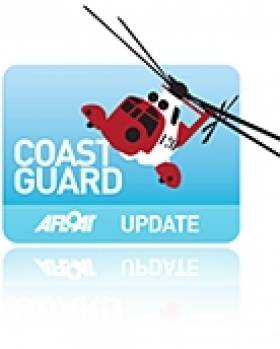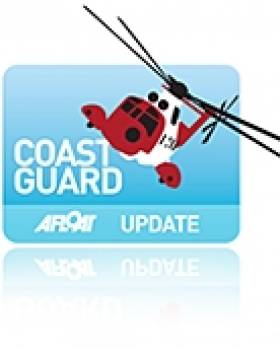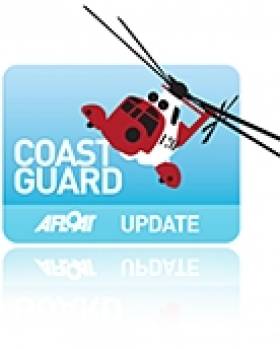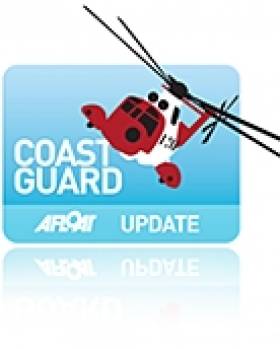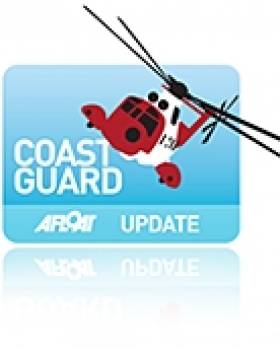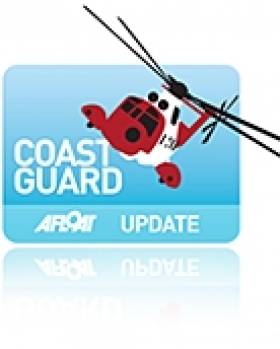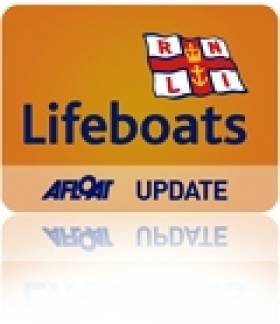Displaying items by tag: Coast Guard
Coast Guard Warning on Jet Ski Dangers
#coastguard – HM Coastguard is again warning people of the dangers of jet skis and personal watercraft (PWC) after a busy summer in North Wales.
Between 1 May and 1 September this year, Holyhead Coastguard dealt with almost 30 incidents involving PWCs. These ranged from mechanical issues, running out of fuel or even concern that PWCs were too close to shore or endangering swimmers.
In one incident over the recent bank holiday weekend, a man and a woman suffered serious injuries after two jet skis collided near Porthmadog. Another incident over the same weekend in Abersoch left a boy with minor injuries after the kayak he was in was struck by a jet ski.
Ray Carson, Rescue Coordination Centre Manager at Holyhead Coastguard, said:
"The majority of PWC users are responsible and often assist us during search and rescue incidents. However, during the summer months we have received complaints that jet skis and PWCs have gone too fast and too close to shore. This is concerning to us as it's putting swimmers and other beach-goers in danger. You should check if any bylaws are in place, stick to them and be respectful of others in the water.
"You also need to make sure you know how to operate these powerful machines. The last thing you want is to find yourself in the water after being thrown off. This is why we always recommend that you wear a buoyancy aid and ensure you're using a kill cord, so if you end up in the water, the engine will stop.
"Remember, if you see anyone in difficulty at the coast, call 999 and ask for the Coastguard."
Inspector Dewi Jones with North Wales Police said:
"Incidents involving inappropriate, unsupervised or careless use of sometimes powerful marine craft impact upon all the emergency services when our resources may be required elsewhere. Unfortunately this summer we have seen incidents locally where people have been injured with only good fortune preventing serious injury or worse.
"Working with HM Coastguard, RNLI and other emergency services I fully support the Coastguards warning and advice and ask all marine craft users to adhere to safety advice, act responsibly and consider others in the water so everyone can enjoy the pleasures of our beautiful beaches and seas."
Coast Guard Recover Boy from Welsh Cliffs
#coastguard – Just before 9pm last night Milford Haven Coastguard received a 999 emergency call reporting a 12–year old boy who had been cut off by the rising tide at Saundersfoot on the Welsh coast.
The boy climbed up the cliff to avoid the rising water and tried to take shelter in undergrowth at Perrys Point, Saundersfoot. Milford Haven Coastguard requested the Tenby lifeboat to the area to locate the casualty.
The weather conditions on scene deteriorated and the boy became stuck in the thick scrub. Windy conditions, complete darkness, low cloud and substantial vegetation prevented the possibility of a helicopter recovery so the Coastguard Rescue Teams from Tenby and St Govans used cliff rescue equipment to locate the boy and lower him safely to the lifeboat crew below, who were talking to and reassuring him throughout the rescue. Once securely onboard the lifeboat the boy was given a Kitkat and can of coke, and was cold but happy and none the worse for his ordeal.
Roger Reed, Milford Haven Coastguard Watch Manager said,
"Always check the weather and tidal conditions before you set out so that you can prepare accordingly. At sea changes in tidal streams could make conditions worse, particularly if the wind and tide are against each other. Tidal heights may hide underwater hazards. Consider whether you could become cut off by the incoming tide, above all do not take risks. Do not attempt to climb cliffs as a short cut back to the top."
#coastguard – Liverpool MRCC has called off the search for two missing anglers off the Isle of Man coast after two bodies were recovered from the sea to the North of the island this afternoon.
Liverpool MRCC (Maritime Rescue Coordination Centre) coordinated an air and sea search covering over 360 square miles of sea, involving RNLI lifeboats from Ramsey, Peel, Port Patrick and Port Erin with rescue helicopters from RAF Valley and RNAS Prestwick.
The Maritime and Coastguard Agency's fixed wing aircraft was also involved in the search as well as vessels in the area which responded to the Coastguard broadcast.
#SAR – The search for two missing anglers off the Isle of Man coast continues today.
Liverpool Coastguard has been working with the Isle of Man Coastguard to find two missing anglers.
Their upturned dinghy was found five miles off the Isle of Man coast at 6.20am on Saturday morning. The men, both in their 60's and from the Isle of Man were reported overdue after failing to return from a fishing trip on Friday afternoon.
Liverpool MRCC (Maritime Rescue Coordination Centre) has coordinated an air and sea search covering over 360 square miles of sea, involving RNLI lifeboats from Ramsey, Peel, Port Patrick and Port Erin with rescue helicopters from RAF Valley and RNAS Prestwick.
The Maritime and Coastguard Agency's fixed wing aircraft was involved in the search this morning but has returned to base due to fog in the search area.
Man Rescued from Mud at Rhyl Harbour
A man's been rescued after becoming stuck up to his waist in mud in Rhyl harbour.
Holyhead Maritime Rescue Coordination Centre (MRCC) was called just before 6am this morning with reports the man was stuck opposite the pontoon in the harbour.
The Rhyl and Flint Coastguard Rescue Teams, both trained in mud rescue, were sent to the scene. The Rhyl RNLI inshore lifeboat was also sent to assist.
Upon arrival, Coastguard Rescue Officers established that the man had been stuck for approximately two hours. Using their mud training techniques, they managed to free the man. He was then passed into the care of the ambulance service and taken to hospital to be checked over.
Barry Priddis, Watch Manager at Holyhead MRCC, said:
"It was lucky that this man was spotted when he was. Having already been in the mud for two hours and stuck up to his waist, we needed to act quickly to get him out.
"Both the Rhyl and Flint Coastguard Rescue Teams put their mud training to good use and were able to extract this casualty.
"If you do find yourself stuck in mud try to spread your weight as much as possible. If you have a mobile phone call 999 and ask for the Coastguard. Avoid moving and stay as calm as you can. Discourage others from attempting to rescue you, since without the proper equipment they could become stuck too."
Minister to Open New Coast Guard Building in Crosshaven
Minister for Agriculture, Food and the Marine Simon Coveney TD will officiate at the opening of a new Coast Guard building tomorrow afternoon in Crosshaven.
The purpose built facility will serve as a Base for Crosshaven Volunteer Coast Guard Unit, as well as a Coast Guard Regional HQ and Training centre. The building can also serve as an emergency management co-ordination centre for use by other statutory services.
Minister Coveney will also present long service medals to Coast Guard volunteers drawn from local Coast Guard Units.
After the ceremony a Coast Guard helicopter will land in the vicinity of the station affording members of the public an opportunity to view the helicopter and meet the crew.
Injured Portuguese Fisherman Rescued Off Pembrokeshire Coast
#coastguard – A Portuguese fisherman has been taken to hospital after suffering a head injury on board a fishing vessel approximately 30 nautical miles west of St. Ann's Head.
Milford Haven Maritime Rescue Coordination Centre (MRCC) was contacted by the French authorities just before midday today to say a fisherman needed to be evacuated.
Watch keeping staff at Milford Haven MRCC tried to make contact with the vessel, but this was made difficult as those on board spoke little English. A member of staff from the MRCC who spoke French, managed to pass on some information.
The RAF search and rescue helicopter from Chivenor was sent to the scene but weather conditions proved too tricky for a winchman to be lowered on to the vessel to recover the casualty. The RNLI all-weather lifeboat from Angle was then requested to launch to meet with the vessel, which was asked to head closer to land to try to find calmer waters. HMS Echo also went to assist. The RAF helicopter returned to the scene and was then able to airlift the casualty and take him to Morriston Hospital in Swansea.
The wind at the time was blowing a south easterly gale force 8 (39-46 mph), with rough seas.
Barrie Yelland, Watch Manager at Milford Haven MRCC, said:
"Due to the weather conditions, this was a challenging rescue for all involved. It was made all the more difficult as those on board the fishing vessel couldn't speak English."
Abandon Ship! The Rescue of the Crew of Wolfhound
#wolfhound – Abandon ship!!! Complete with its insistent screamers (that's exclamation marks to you and me), it's such a hoary old nautical cliché that when it happens, you expect awesome background music to roll, with the blackest of black clouds overhead tearing apart to reveal some majestic and divine portent.
But the reality these days is that with well-established International Laws of the Sea in place, and time-tested global rescue procedures working effectively supported by the latest in basic emergency radio communication, once it has moved beyond a life-and-death situation with the rescue achieved, it very quickly becomes a humdrum matter of filing reports, completing forms, and submitting to official enquiries.
Such routine is important for everyone, and not least the rescued. It puts their experiences into perspective, it makes them realise that what has happened to them is not horribly unique, and it gives them a reasonable feeling that while they have suffered an acute personal setback, perhaps it can now be of some benefit to others. By slipping into established post-rescue formalities and analysis, the process of mental and physical recovery can be quietly begun.
Obviously the situation is completely different if there has been loss of life. But happily, in the matter of the rescue of the crew of four from the Irish-owned Swan 48 Wolfhound 70 miles off Bermuda on the morning of Saturday February 9th 2013, apart from one non-acutely wounded hand, there was no serious injury involved. So we can now examine how a very attractive project to take part in the sun-filled RORC Caribbean 600 Race in a fine 12-year-old Swan 48 newly-purchased in New England, and subsequently sail the boat home across the Atlantic to Ireland after cruising the Caribbean, became so totally unravelled in an extreme winter storm in the Gulf Stream.
Alan McGettigan (52) has made his career in the oil and gas exploration business. One of the founders of successful frontline operator Petroceltic, his work has taken him to harsh and volatile places which, if they weren't already dangerous to be in at the time, inevitably became dangerous with their added strategic significance when his prospecting was successful. It was a working life outside normal comfort zones, so as a sailing enthusiast – when he could get the time – he also pushed the limits of the possibilities in cruising.
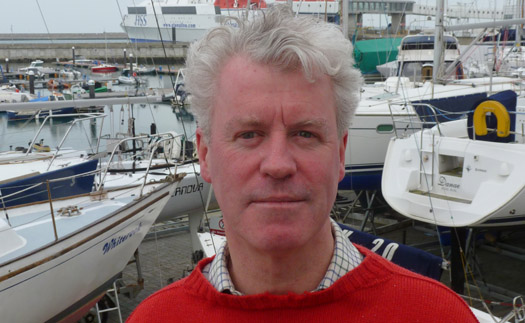
Alan McGettigan in Dun Laoghaire 27/02/13 Photo: W M Nixon
A dozen or so years ago, he bought a Ron Holland-designed Swan 43 which he called Wolfhound. Though time was initially limited, six years ago he began a long-term cruise aimed at circumnavigating western Europe, beginning with a west-east transit of the Mediterranean in which – unusually – he focused in the early stages on the coast of North Africa.
Being very much part of the Dun Laoghaire sailing community, he has like-minded friends – many of them boat-owners themselves – to make up a crew panel on which he could draw for congenial ship's company, people who in turn were enthused by his interest in going to unusual places. Despite the turmoil in the region, with each succeeding season Wolfhound found herself getting further east, and in time she explored the Black Sea in some detail before – in the summer of 2011 – she shaped her course into the Danube.
But after the worst drought in a hundred years, the great river's levels were so low that Wolfhound's draught prevented them getting any further than fifty kilometres upriver, so they returned to the Black Sea coast, and arranged to lay the boat up afloat for the winter in the attractive Romanian port of Constanta. But then in November, too late to move to another port, Alan had a call from the harbour that they required Wolfhound to be lifted out and laid up ashore, for which the yard would provide the cradle.
Although he preferred her to be afloat in the sheltered little marina, he flew out and supervised the transfer ashore. Then in January the yard was in contact again to say that an extreme winter storm was moving south from Siberia, and there was a danger that boats ashore on the quay would be engulfed in snow and ice. But the weather was already so bad that Constanta airport was closed down. So Alan could do nothing but await the worst as the yard emailed him photos which showed Wolfhound disappearing under her own private iceberg which eventually weighed more than ten tonnes. The cradle collapsed, and the boat sustained further serious damage in falling on her side under yet more snow and ice.
Although badly damaged, she was repairable, yet she would only be acknowledged as a proper Swan if the repairs were done by Nautor Swan themselves in Finland. But that process with its long transportation would be prohibitively expensive. The insurers preferred a yard they'd found in Bulgaria. Eventually, the stalemate was broken with a deal in June, the insurers paying up the insured value, and keeping the damaged boat.
So Alan found himself boatless in June 2012, but with an unexpected accumulation of significant boat-buying resources, as he sold up his shareholding in Petroceltic in 2012. The world was his oyster, or rather his Swan, and he toyed with the idea of an attractive readily-available Swan 60 in the south of France, and a Swan 651 in the UK.
But this resulted in a certain thoughtful sucking-in of the breath among his regular crew panel. They pointed out that if he was seduced into going above a certain size, their cosy all-friends-together-as-equals arrangement would almost certainly be disrupted by the need to carry professional crew, particularly if the boat was going to be moving around exotic and distant locations.
Those of us who mess about in smaller boats are happily untroubled by this critical change of boat management requirements above a certain size. Indeed, it's a problem for which most of us would have scant sympathy. But it is very real for those who have the means and inclination for a larger boat in which they can really cover the ground and get comfortably, if somewhat impersonally, to distant places, if they're prepared to go with the potentially disruptive presence of professional crew making them feel like passengers on their own boat.
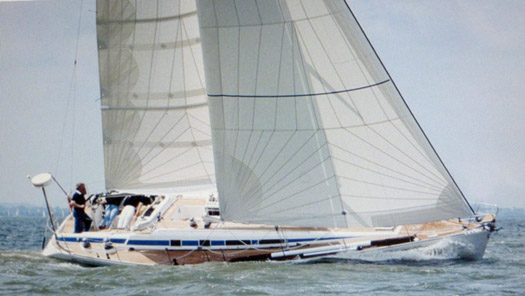
"A modern Moonduster". The Frers-designed Swan 48 is nearly 50ft long, and is an up-dated glassfibre sister of Denis Doyle's famous Moonduster
By September 2012, however, things were back on track with the location of a 12 year old Swan 48 in Connecticut. Originally designed by German Frers in 1994, the boat is actually just a matter of inches under 50ft LOA, which made her the equivalent of an up-dated production version of Denis Doyle's legendary Moonduster. As one of the senior members of the eclectic McGettigan Crew Panel had sailed many successful races with The Doyler on The Duster, it was reckoned that this was all as it was meant to be, as it offered the additional prospect of an immediate season or two in the Caribbean with a boat which was of a size to be still manageable without a professional crew.
This also offered the possibility of racing the Caribbean 600 in February 2013, an attractive idea as the boat came with a formidable wardrobe of sails. But if that aim was to be comfortably fulfilled, the boat had to be ready to sail south to the Caribbean in November, when fleets of boats make the journey south from New England as soon as the hurricane season is over.
However, with Superstorm Sandy wreaking havoc in the New York coastal area in September, it was impossible to bring things to fruition as quickly as hoped. Despite the shared language, buying a boat in the US can be much more difficult than buying one in Europe. And as you finally do close the deal, you are already discovering that boats in America, while seemingly identical to their sister-ships in Europe, can often carry very different equipment.
So the programme slipped, but by late November Alan was doing sea trials on Long Island Sound with a surveyor, and by early December he had been given a favourable report, and negotiations were drawing towards a conclusion through a broker with an owner - never personally met - who lived in another distant American state.
Finally, with the seller faced with the exigencies of the end of the tax year on December 31st, the deal was concluded on that last day of 2012. Meanwhile, back in Ireland over the Christmas/New Year holiday, the crewing arrangements were firmed up between those who were to do the delivery passage in late January/early February from Connecticut to the Caribbean via Bermuda, those who then wished to do the Caribbean 600 Race on February 18th, and those who would cruise the islands afterwards.
It was a very busy time with the new boat, now re-named Wolfhound, being transferred to Irish ownership with details like the IRC rating being re-issued by the ISA. But on 25th January Alan and three long-time shipmates arrived in Connecticut knowing that the weather prospects were bad with Snowstorm Nemo developing over the northeast United States, but equally knowing that a favourable weather window would follow it.
However, they knew there were some days of work to be done in any case before they could sail, and by the time that was completed the economy of Connecticut had benefited from the Wolfhound campaign by a significant amount. As expected, a new top-of-the-range Viking liferaft had to be installed, but less clearly expected was the necessary acquisition of a new Zodiac inflatable tender and outboard, and completely inexplicable was the need to install a new Charger/Inverter, the original having disappeared. The boat, in other words, was not precisely as Alan remembered her from the last time he'd seen her in early December, but with goodwill all round she was made ready for sea.
Thanks to friends in the Cruising Club of America, Alan and his crew had a briefing session with people well used to sailing the 650 miles to Bermuda at 1215 on Saturday 2nd February, and at 1530 hrs they headed out round the northeast end of Long Island and shaped their course parallel with the American coast towards Cape May in order to slip between weather systems and get in to more clement conditions as quickly as possible, for though the winds were favourable northerlies and easing after the storm force winds of Nemo, the temperature was minus 8.
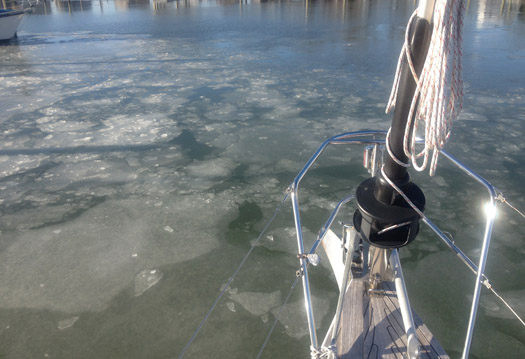
Getting through the ice departing from Connecticut on the afternoon of Saturday February 2nd. As darkness drew on, the temperatures plunged. Photo: Alan McGettigan
In such conditions, it was so cold that they motored with only the mainsail set, and put in watches of only half an hour. But progress was good and through Day 2 (Sunday February 3rd), everything was going according to plan, they were finding their weather window, and it was even getting slightly – just very slightly – warmer, as by now the wind was easterly, though as it was 30 knots with some gusts to 50 knots it was by no means the "champagne sailing" they'd been promising themselves once they got down to Cape May.
By Monday morning conditions permitted one hour watches and soon they were sailing properly, but there was concern about a new weather system developing to the eastward in the tail of Storm Nemo. However, satisfactory progress was being maintained and they were able to move up to two hour watches with half hour rotations. The going was good, but that was as good as it was to get. In order to keep up battery power, they tried to put the new Mastervolt Charger/Invertor into service on the remote setting, but the indicator light failed to show. This was serious. They were halfway through the passage to Bermuda, but knew that unless someone aboard suddenly discovered his own previously unrevealed genius as an electrical and electronics engineer, by Day 4 (Tuesday February 5th), all systems except the engine would be down through lack of power – this duly happened at 0350hrs on the Tuesday.
They were now halfway between the American mainland and Bermuda, but with the frequently changing wind by this time from the west, it didn't make sense to try to beat for the Chesapeake as the nearest mainland all-weather port of refuge, even if Bermuda is a place difficult of access. So they pressed on, but later on the Tuesday the engine failed to re-start. It was found that it could be run intermittently, and as it had been serviced before leaving, the suspicion was that grunge in the fuel tank – the boat had been effectively out of commission for more than a year – was causing fuel blockages, so they made do without the motor, as any use would only make the blockage problem worse, and maybe damage the engine.
Their situation was seriously unpleasant, for although cooking had been by gas, the top-of-the-line American marine cooker relied on an electrically-powered safety switch for its ignition. So for the time being they endured cold food – mostly breakfast cereals and fruit – and resisted the temptation to cut the gas line and by-pass the safety connection to the stove, though without heating of any sort and only cold food, the effect on morale was dire.
By now they were getting into very bad weather again with huge seas and rising winds, and on Day 5 (Wednesday February 6th) the furled headsail (it was the Number 4) was simply shredded by the strength of the wind despite being rolled. But conditions had eased enough the following day to get the remains down and cleared from the forestay.
Despite everything, they were getting near Bermuda, for even with their problems they had averaged 5.5 knots from Connecticut. But the weather was once again deteriorating, and now their sense of being cut off from all assistance was exacerbated by the discovery that their hand-held VHF was completely discharged, even though it had been fully charged ashore prior to departure, while their location was too remote for personal mobiles to be of any use.

So near and yet so far.....Wolfhound's route towards Bermuda
So with all systems down, visibility very poor and conditions deteriorating, with the vessel getting a horrendous pounding with a couple of knockdowns and chaotic dislocation below to such a degree that it was safer to remain on deck, the only navigational information available was through a single iPad which was already down to 15% power. But even if they could find their way the final fifty miles to Bermuda, they had no engine power to get through the intricate reefs and St George's Channel.
Throughout all this, Alan recalls that he never heard a voice raised in anger or frustration – he had shipmates to cherish. And that's what he did. He cherished them. Much and all as he'd had great hopes for his new boat, he decided that the risks to life and limb in trying to make the final rock-strewn miles to Bermuda were simply too great. It was a choice of putting his friends' lives at great risk, or abandoning ship. It was no contest. He activated the EPIRB at 1530 hours on Friday February 8th.
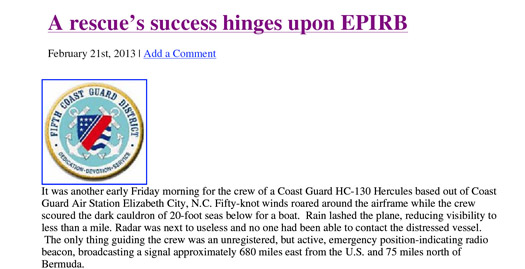
The offiial US Coastguard report into the rescue is downloadable below as a PDF document
As the American authorities couldn't immediately trace the registration of the EPIRB (see downloadable PDF of Coastguardnews below) they didn't at first know what they were looking for, but that Friday night, Wolfhound was located in darkness by a US Coastguard C130 Hercules aircraft from Norfolk, Virginia, which dropped emergency supplies and more importantly indicated to them that help was on the way. Meanwhile Bermuda MRCC instructed two ships in the area, the Empire Champion and the Tetien Trader, to alter course towards Wolfhound.
The Empire Champion was unladen, which made manoeuvring in the extreme weather difficult, but the fully-laden Greek ship Tetien Trader arrived at dawn on Saturday February 9th and did the job. Floating deep, she provided an almost rock-like base onto which the crew of Wolfhound, which was alongside with long warps fore and aft, could be hauled aboard by the sheer brute strength of eight men pulling on a heavy warp which the Irish crew had to tie round themselves using a bowline knot.
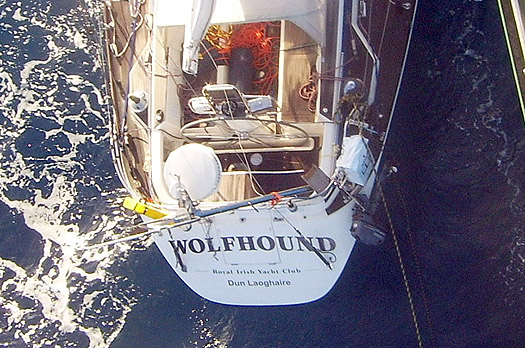
The chaos of Wolfhound's cockpit seen as she lay briefly alongside Tetien Trader during the rescue. Photo: Alan McGettigan
Throughout all this, in a cruel twist the sky had temporarily cleared and there was even a hint of sunshine before the next wave of bad weather closed in again later in the morning, During the rescue, the yacht was rising and falling fifteen to twenty feet up the steel side of the ship, but after the crew had been hauled to safety, the extreme conditions soon snapped the warps holding Wolfhound alongside, and she drifted away. She was not seen to sink, as some reports have suggested, and might even be still out there, alone on the ocean. Her crew meanwhile headed east across the Atlantic on the Tetien Trader, and were landed at Gibraltar on Wednesday February 20th.
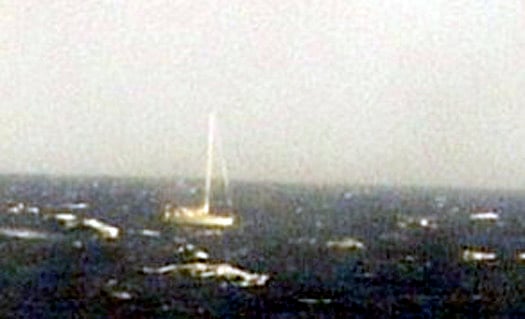
Last glimpse of Wolfhound from Tetien Trader before the weather closed in again. Photo: Alan McGettigan
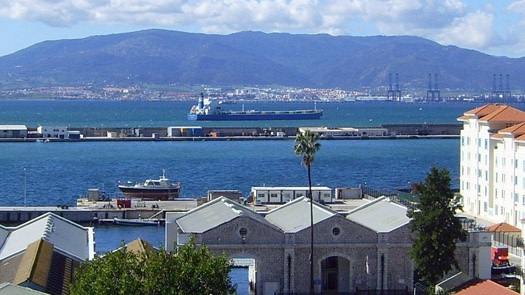
Journey's end. Tetien Trader in Gibraltar on February 20th. Photo: Alan McGettigan
As for what might be learnt from this sad story, that can be analysed in due course, but all that can be said this morning is that it could have been much worse. No lives were lost, nobody was seriously injured. In extremis, the right and proper priorities were observed. Life can go on. Indeed, it was going on almost immediately. On the Transatlantic passage on the Tetien Trader, Declan Hayes was moved to pen some poetry:
Wolfhound (the adventures of Alan, Morgan, Declan & Tom)
Dublin, Boston, then Bermuda bound
To start our journey on the new Wolfhound
Tortola, Antigua, Azores and home
Cutting through the Atlantic foam
It was oh so very, very cold
As we set out on our journey bold
Dreaming of the warm Gulf Stream
And the Caribbean sun on our beam
But that was never going to be
As we battled wind and heavy seas
All power went and food was low
As we were battered about in the merciless blow
We signalled help by satellite
But no help came until the night
The drone of engines in the sky
Then searchlights allowed them us to spy
By daylight two ships had answered our call
But we could not board due to swell and squall
Persistence paid and one by one
We were hoisted aboard, it was no fun!
Wolfhound crashed against the mighty hull
Then broke her lines with a mighty pull
She drifted past the stern abeam
The end of Alan's epic dream
Aboard the ship, the Tetien Trader
Our lives intact, disappointment faded
A nicer crew you could not have chosen
The captain, cook, not least the bo'sun
Ten days we spent on that good ship
Before they let us off at the Rock of Gib
A trip I doubt we will ever forget
So very different from travelling by jet!
The moral of the story is plain to see
You never know what's going to be
Life is precious and full of hope
A boat's just plastic, metal and rope
Time will pass and memories fade
But the experience is there, forever made
Another part of who you are
Another story for the bar!
Comment on this story?
We'd like to hear from you on any aspect of this blog! Leave a message in the box below or email William Nixon on [email protected]
Fishing Vessel Crew Rescued off Campbeltown Loch
#rescue – Four fishermen were rescued by Campbeltown RNLI Lifeboat in the early hours of this morning after their fishing vessel began taking on water off Campbeltown Loch.
The vessel broadcast a mayday message at 2.30 am this morning reporting that it was taking water and required immediate assistance. The Campbeltown RNLI lifeboat was requested to launch and the Campbeltown Coastguard Rescue Team was sent to the scene. A Navy rescue helicopter from Prestwick was also scrambled.
Gary Young, Watch Manager at Belfast Coastguard stated
"Campbeltown Lifeboat was quick to arrive on scene and safely transferred all four fishermen from their stricken vessel, with no reported injuries. The fishing vessel remains aground and will be assessed at first light."
Fishermen Rescued after Vessel Sinks off County Down Coast
#coastguard – Two fishermen have been rescued after the fishing vessel Snowdonia sank approximately 12 miles east of Kilkeel Harbour on the County Down coast.
Belfast Coastguard received a call from the fishing vessel Tribute reporting that they had recovered two fishermen from the water. The RNLI lifeboat from Kilkeel and the Irish Coast Guard Search and Rescue helicopter were sent to the scene. The crew of Kilkeel Inshore Lifeboat were quickly on scene and provided first aid until the arrival of the Irish Helicopter.
The two crew were airlifted to Daisy Hill Hospital, Newry where they are currently being assessed.
Gary Young, Watch Manager Belfast Coastguard, said: "This incident has again proved the importance of wearing a lifejacket and having it maintained to a high standard.
"I would like to pass on my thanks to the professionalism of the lifeboat and helicopter crews."
Additional reporting from RNLI:
The volunteer lifeboat crew with Kilkeel RNLI were today involved with a local fishing vessel and the Irish Coast Guard helicopter from Dublin in the rescue of two fishermen after the boat they were in sank off the Down coast. The men were ten miles from Kilkeel when the boat started to take in water and the alarm was raised.
Kilkeel RNLI received the call for assistance at 10.30am this morning (Tuesday 23 October 2012) and immediately launched and made their way to the scene. When the lifeboat crew arrived the vessel had sank and the two men had been taken onboard another fishing vessel, which was in the vicinity and able to respond to the callout. The fishermen had been in the water for a few minutes before they were pulled to safety and were feeling the effects of the freezing cold water.
A lifeboat crewmember from Kilkeel RNLI was transferred onto the vessel where they administered first aid and oxygen to the freezing men. On the arrival of the Dublin Coast Guard helicopter the two men were airlifted onboard and taken to Daisy Hill Hospital in Newry.
Commenting on the callout Roy Teggerty, Kilkeel RNLI Lifeboat Operations Manager said, "The two fishermen were extremely lucky. Thanks to the quick action of the passing fishing vessel along with the Kilkeel RNLI lifeboat and Dublin Coast Guard the men were recovered from the water very quickly and received first aid. I wish the men a full recovery from their ordeal.



























